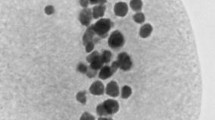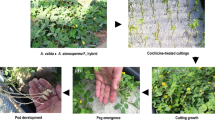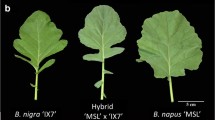Summary
Of the four interspecific hybrids, three (A. graecizans var. graecizans X A. tricolor cv. ‘Purple leaf’, A. lividus var. lividus X A. tricolor var. viridis and A. gracilis X A. tricolor cv. ‘Purple leaf’) were studied cytologically. In all the three, differentiation between the parents is chiefly a result of interchanges and paracentric inversions. The interchange complexes may involve from four (A. gracilis X A. tricolor cv. ‘Purple leaf’) to fourteen (A. lividus var. lividus X A. tricolor var. viridis) chromosomes, indicating that the parents differ from each other in 1 to 6 interchanges. Because of the small size of the chromosomes, it is possible that crossing-over in interchange for small segments is restricted. The particular parental species representing the ancestral condition from which others were derived or compounded is difficult to pin-point. With preferential pairing and the restoration of fertility in the amphidiploid A. lividus-tricolor, it became clear that it is very likely that the interchanged segments are small and sterility in the hybrid is entirely chromosomal.
This situation is in strong contrast to that in Sect. Amaranthus, where the single male flower per glomerule and huge showy inflorescences lead to more cross-pollination; coupled with this are strong morphological divergences between taxa and less genetic differentiation. In the Sect. Blitopsis, there are a number of male flowers per glomerule and small non-showy axillary inflorescences, leading to self-pollination, and less morphological but strong genetic differentiation by interchanges and inversions.
Similar content being viewed by others
Literature
Aellen, P.: Die Amaranthaceen Mitteleuropas. München: Carl Hanser Verlag 1961.
Ahloowalia, B. S.: Study of a translocation in tetraploid rye. Genetica 33, 207–221 (1963).
Avery, A. G., Satina, S., Rietsema, J.: Blakeslee: The genus Datura. New York: The Ronald Press Company 1959.
Braungart, D. C.: Meiosis in colchicine induced tetraploids of Rhoeo. J. Heredity 40, 25–58 (1949).
Burnham, C. R.: Chromosomal interchanges in plants. Bot. Rev. 22, 419–552 (1956).
Clausen, J., Keck, D. D., Hiesey, W. M.: Experimental studies on the nature of species. II. Plant evolution through amphidiploidy and autopolyploidy with examples from Madiinae. Carnegie Inst. Washington, Publ. no. 564 (1945).
Cleland, R. E.: Phylogenetic relationships in Oenothera. Proc. 8th Intern. Congr. Genet. Stockholm. Hereditas (Suppl.) 35, 173–188 (1949).
Darlington, C. D.: Recent advances in cytology. London: J. and A. Churchill Ltd. 1965.
Doyle, G. G.: Preferential pairing in structural heterozygotes of Zea mays. Genetics 48, 1011–1027 (1963).
Garber, E. D.: The genus Collinsia. IX. Speciation and chromosome repatterning. Cytologia 25, 233–243 (1960).
Garber, E. D., Dhillon, T. S.: The genus Collinsia. XVII. Preferential pairing in four amphiploids and three triploid interspecific hybrids. Canad. J. Genet. Cytol. 4, 6–13 (1962).
Gerstel, D. U.: Chromosomal translocations in interspecific hybrids of the genus Gossypium. Evolution 7, 234–244 (1953).
Gill, K. S., Yermanos, D. M.: Cytogenetic studies on the genus Linum. I. Hybrids among taxa with 15 as the haploid chromosome number. Crop Sci. 7, 623–627 (1967a).
Gill, K. S., Yermanos, D. M.: Cytogenetic studies on the genus Linum. II. Hybrids among taxa with nine as the haploid chromosome number. Crop Sci. 7, 627–631 (1967b).
Grant, V.: Chromosome repatterning and adaptation. Advances in Genetics 8, 89–107 (1956).
Grell, E. H.: Variations in preferential segregation of chromosome two in triploid females. Genetics 46, 1267–1271 (1961).
Holden, J. H. W.: Species relationships in Avenae. Chromosoma (Berl.) 20, 75–124 (1966).
John, B., Lewis, K. R.: The meiotic system. Protoplasmatologia 6, 1–335 (1965).
Khoshoo, T. N., Mukherjee, Iva: A translocation heterozygote in garden Canna. Genetica 37, 255–258 (1966).
Khoshoo, T. N., Pal, M.: Cytogenetic patterns in Amaranthus. Chromosomes Today 3, 259–267 (1972).
Khoshoo, T. N., Raina, S. N.: An interchange heterozygote in garden Crinum. Jour. Cytol. Genet. 2, 6–9 (1967).
Khush, G. S.: Cytogenetic and evolutionary studies in Secale. II. Interrelationships of the wild species. Evolution 16, 484–496 (1962).
Lewis, H.: The mechanism of evolution in the genus Clarkia. Evolution 5, 142–157 (1953).
Lewis, H.: Speciation in flowering plants. Science 152, 167–172 (1966).
Lewis, K. R., John, B.: Studies in Periplaneta americana. II. Interchange heterozygosity in isolated populations. Heredity 11, 11–21 (1957).
Lewis, H., Lewis, M. E.: The genus Clarkia. Univ. Calif. Publ. Bot. 20, 241–392 (1955).
Lewis, H., Raven, P. H.: Rapid evolution in Clarkia. Evolution 12, 319–336 (1958).
Linnert, G.: Untersuchungen an hemiploiden Nachkommen Autotetraploider. I. Der Verteilungsmodus einer reziproken Translokation und die daraus folgende Erhöhung der Heterozygotenfrequenz in der Nachkommenschaft von Duplex-heterozygoten. Z. Vererbungsl. 93, 389–398 (1962).
Mosquin, T.: Chromosome translocations in Epilobium. Can. J. Genet. Cytol. 10, 794–798 (1968).
Pal, M., Khoshoo, T. N.: Evolution and improvement of cultivated amaranths. VI. Cytogenetic relationships in grain types. Theor. Appl. Gen. 43, 242–251 (1973).
Raven, P. H., Lewis, H.: The relationship of clarkias from two continents. Brittonia 11, 193–205 (1959).
Rees, H.: The consequences of interchange. Evolution 15, 145–152 (1961).
Riley, R.: The cytogenetics of the differences between some Secale species. J. Agric. Sci. 46, 377–383 (1955).
Shaver, D. L.: A study of meiosis in perennial teosinte, in tetraploid maize and their tetraploid hybrid. Caryologia 15, 43–57 (1962).
Shaver, D. L.: The effect of structural heterozygosity on the degree of preferential pairing in allotetraploids of Zea. Genetics 48, 515–524 (1963).
Snow, R.: Chromosomal differentiation in Clarkia dudleyana. Amer. J. Bot. 47, 302–309 (1960).
Stebbins, G. L.: Types of polyploids: their classification and significance. Advances in Genetics 1, 403–429 (1947).
Stebbins, G. L.: Variation and evolution in plants. New York: Columbia Univ. Press 1950.
Sybenga, J.: Reciprocal translocations and preferential pairing in autotetraploid rye. In: Chromosomes Today pp. 66–67. London: Oliver and Boyd 1966.
Sybenga, J.: Orientation in interchange multiples in Secale cereale. Heredity 23, 73–79 (1968).
Vasek, F. C.: A Cytogenetic study of Clarkia exilis. Evolution 14, 88–97 (1960).
Venketaswarlu, J., Rao, P. N.: Meiosis in diploid and colchicine induced tetraploid Zebrina pendula Schinz., a structural hybrid. Cytologia 28, 305–320 (1963).
Walters, M. S., Gerstel, D. U.: A cytological investigation of a tetraploid Rhoeo discolor. Amer. J. Bot. 35, 141–159 (1948).
Zadoo, S., Khoshoo, T. N.: Cytogenetical studies on Bougainvillea. I. A case of interchange heterozygosity. Genetica 39, 353–359 (1968).
Author information
Authors and Affiliations
Additional information
Communicated by F. Mechelke
Rights and permissions
About this article
Cite this article
Pal, M., Khoshoo, T.N. Evolution and improvement of cultivated amaranths. Theoret. Appl. Genetics 43, 343–350 (1973). https://doi.org/10.1007/BF00278171
Received:
Issue Date:
DOI: https://doi.org/10.1007/BF00278171




